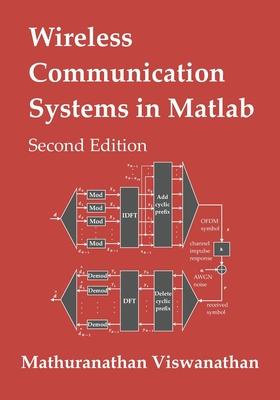
Book
Wireless Communication Systems in Matlab: Second Edition (Black & White Print)
(Write a Review)
Paperback
$29.66
* Random variables for simulating probabilistic systems and applications like Jakes filter design and colored noise generation.
* Models for Shannon's channel capacity, unconstrained awgn channel, binary symmetric channel (BSC), binary erasure channel (BEC), constellation constrained capacities and ergodic capacity over fading channel. The theory of linear block codes, decoding techniques using soft-decisions and hard-decisions, and their performance simulations.
* Monte Carlo simulation for ascertaining performance of digital modulation techniques in AWGN and fading channels - Eb/N0 Vs BER curves. Pulse shaping techniques, matched filtering and partial response signaling, Design and implementation of linear equalizers - zero forcing and MMSE equalizers, using them in a communication link and modulation systems with receiver impairments.
* Large-scale propagation models like Friis free space model, log distance model, two ray ground reflection model, single knife-edge diffraction model, Hata Okumura model.
* Essentials of small-scale propagation models for wireless channels, such as, power delay profile, Doppler power spectrum, Rayleigh and Rice processes. Modeling flat fading and frequency selective channels.
* Diversity techniques for multiple antenna systems: Alamouti space-time coding, maximum ratio combining, equal gain combining and selection combining.
* Simulation models for direct sequence spread spectrum, frequency hopping spread spectrum and OFDM.
* Random variables for simulating probabilistic systems and applications like Jakes filter design and colored noise generation.
* Models for Shannon's channel capacity, unconstrained awgn channel, binary symmetric channel (BSC), binary erasure channel (BEC), constellation constrained capacities and ergodic capacity over fading channel. The theory of linear block codes, decoding techniques using soft-decisions and hard-decisions, and their performance simulations.
* Monte Carlo simulation for ascertaining performance of digital modulation techniques in AWGN and fading channels - Eb/N0 Vs BER curves. Pulse shaping techniques, matched filtering and partial response signaling, Design and implementation of linear equalizers - zero forcing and MMSE equalizers, using them in a communication link and modulation systems with receiver impairments.
* Large-scale propagation models like Friis free space model, log distance model, two ray ground reflection model, single knife-edge diffraction model, Hata Okumura model.
* Essentials of small-scale propagation models for wireless channels, such as, power delay profile, Doppler power spectrum, Rayleigh and Rice processes. Modeling flat fading and frequency selective channels.
* Diversity techniques for multiple antenna systems: Alamouti space-time coding, maximum ratio combining, equal gain combining and selection combining.
* Simulation models for direct sequence spread spectrum, frequency hopping spread spectrum and OFDM.
Paperback
$29.66